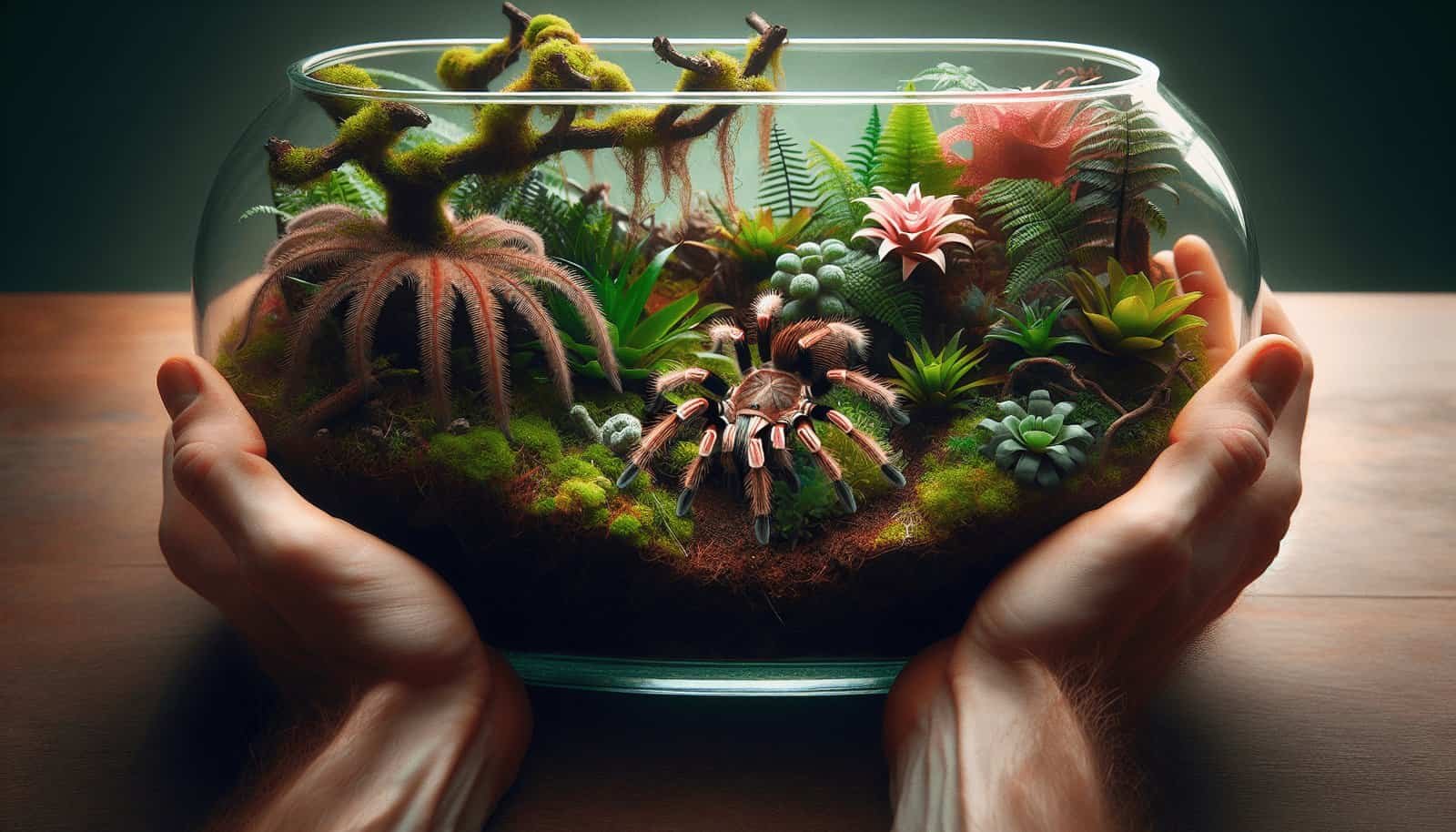If you’re a fan of exotic pets and are looking to create the perfect habitat for your new addition, look no further than the charismatic pink toe tarantula. This beautiful arachnid, known for its striking coloration and tree-dwelling habits, deserves a biome that not only mimics its natural environment but also promotes a healthy and active lifestyle. In this article, we will guide you through the art of creating a bioactive setup that will keep your pink toe tarantula happy and thriving. From substrate choice to suitable plants and hiding spots, you’ll soon find yourself fully equipped to provide the ultimate home for your new eight-legged friend.
Choosing the Right Enclosure
When it comes to choosing the right enclosure for your pink toe tarantula, there are a few key factors to consider. Firstly, you’ll want to think about the size and shape of the enclosure. Tarantulas are generally more comfortable in taller enclosures rather than wider ones, as they prefer to climb and have plenty of vertical space. Additionally, the enclosure should be large enough to accommodate some hiding spots, as well as any additional decor or accessories you might want to include.
Next, consider the material of the enclosure. Glass or plastic enclosures are usually the most common choices for tarantulas, as they provide good visibility and are easy to clean. It’s important to avoid enclosures with mesh or screen walls, as tarantula legs can easily become trapped or damaged in these types of enclosures.
Lastly, ventilation and accessibility are important factors to consider. While tarantulas require good air circulation, it’s crucial to strike a balance to prevent the enclosure from becoming too dry or too humid. Look for an enclosure that provides adequate airflow while also allowing you easy access for feeding, cleaning, and maintenance.
Substrate and Drainage
Choosing the right substrate is essential for creating a bioactive setup for your pink toe tarantula. Natural substrate options like coco fiber or peat moss are ideal, as they are able to hold moisture and provide a more natural environment. These substrates also allow for burrowing, which is a natural behavior for tarantulas.
To ensure proper drainage, it’s important to create a drainage layer at the bottom of the enclosure. This can be achieved by adding a layer of small rocks or gravel. This layer will help prevent water from pooling at the bottom of the enclosure and potentially causing issues with mold or stagnant water.
Maintaining substrate moisture is crucial for the overall well-being of your pink toe tarantula. Regularly misting the enclosure with dechlorinated water can help maintain humidity levels, but be careful not to oversaturate the substrate. It’s also important to monitor the moisture levels and adjust as necessary to prevent the substrate from becoming too dry or too damp.
Creating Hiding Spots
Providing hiding spots is essential for the comfort and security of your pink toe tarantula. Cork bark and hollow logs are great natural options for creating hiding spots. These structures provide both a place for your tarantula to retreat to when it feels stressed, as well as a surface for climbing and web building.
Leaf litter and rocks can also be used to create additional hiding spots. Tarantulas often use leaf litter as a soft substrate to burrow into, while rocks can provide a natural hiding spot that mimics their natural habitat.
If you prefer artificial decorations, there are a variety of options available on the market. Fake plants, caves, and other decorations can be used to create hiding spots and add visual appeal to the enclosure. Just make sure to choose decorations that are safe for tarantulas and won’t cause any harm or discomfort.
Temperature and Humidity Control
Maintaining the right temperature and humidity levels is crucial for the health and well-being of your pink toe tarantula. The ideal temperature range for most species of tarantulas is between 75-85°F (24-29°C). To achieve this temperature range, you can use heating devices such as under-tank heaters or heat mats. These can be placed on one side of the enclosure, allowing your tarantula to thermoregulate by moving closer or further away from the heat source as needed.
Humidity is another important factor to consider. Pink toe tarantulas require a humidity level of around 70-80%. This can be achieved by misting the enclosure with dechlorinated water and using a hygrometer to monitor the humidity levels. It’s important to strike a balance, as too much humidity can lead to mold or mite issues, while too little humidity can cause dehydration.
Choosing the Right Lighting
While tarantulas do not require direct lighting, they still benefit from having access to natural daylight. Placing the enclosure in a room with indirect sunlight can provide a natural light source for your pink toe tarantula. Avoid placing the enclosure in direct sunlight, as this can cause overheating and create temperature fluctuations.
It’s also important to provide a dark hideout within the enclosure. This can be achieved by using a piece of cork bark or a small hut-like structure. Tarantulas are nocturnal creatures, and having a dark hiding spot allows them to feel safe and secure during their resting periods.
In addition to natural lighting and a dark hideout, you can add a gentle heat source to the enclosure. Heating pads or heat lamps can be used to create a warm spot within the enclosure, allowing your tarantula to increase its body temperature if needed.
Feeding and Watering
Feeding your pink toe tarantula live prey is essential for its nutrition and overall well-being. Offer a variety of appropriately sized insects, such as crickets, roaches, or mealworms. Make sure the prey items are gut-loaded (fed nutritious food) before feeding them to your tarantula. Always remove any uneaten prey after a couple of hours to prevent it from harming your tarantula or the enclosure.
Water is also crucial for your tarantula’s survival. Place a shallow water dish in the enclosure, making sure it is easily accessible for your tarantula. Keep the dish filled with clean, fresh water at all times, replacing it regularly to ensure cleanliness. However, be cautious not to create excessive moisture in the enclosure that could lead to mold or other issues.
To supplement your pink toe tarantula’s diet, you may also consider providing calcium. Calcium powder can be dusted onto the prey items before feeding to ensure your tarantula is getting the necessary nutrients for its exoskeleton.
Maintaining Cleanliness
Keeping the enclosure clean is important for the overall health and well-being of your pink toe tarantula. Spot cleaning involves removing any uneaten prey, molts, or waste from the enclosure on a regular basis. This helps prevent the buildup of bacteria or other harmful substances.
To prevent mold and fungal growth, it’s important to maintain proper moisture levels in the substrate. Avoid over-misting or allowing excessive moisture to accumulate in the enclosure. If you notice any mold or fungal growth, remove the affected substrate and replace it with fresh, clean substrate.
Regularly replacing the substrate is also important to maintain cleanliness and prevent any potential issues. Depending on the size of your tarantula and the enclosure, substrate replacement can be done every few months to a year.
Monitoring and Environmental Enrichment
Observing your pink toe tarantula’s behavior is crucial for understanding its needs and ensuring its well-being. Pay attention to its feeding patterns, activity levels, and any changes in behavior. This will help you gauge its overall health and make any necessary adjustments to its environment or care routine.
Introducing safe climbing opportunities can provide mental and physical stimulation for your tarantula. Adding branches or other structures within the enclosure allows your tarantula to climb and explore, mimicking its natural habitat. Just make sure the climbing surfaces are secure and won’t cause any harm or stress to your tarantula.
Integrating live or artificial plants and faux foliage can also help enrich the environment. These additions can provide hiding spots, visual interest, and a more naturalistic feel to the enclosure. However, ensure that any live plants used are non-toxic to tarantulas.

Handling and Care
Generally, it’s best to avoid handling your pink toe tarantula unless it is necessary. Tarantulas are delicate creatures and can be easily injured if mishandled. Additionally, they have urticating hairs, which they may kick off when feeling threatened or stressed. These hairs can cause irritation or allergic reactions in humans.
If handling is required, it’s important to understand defensive behaviors and take necessary precautions. Tarantulas may exhibit threat displays, such as raising their front legs or rearing up. Respect their boundaries and handle them with extreme care, ensuring you have a secure grip and minimal contact with their delicate bodies.
In the event that you’re unsure about the health or behavior of your pink toe tarantula, it’s always best to seek professional help. Veterinarians or experienced tarantula enthusiasts can provide guidance and assistance in addressing any concerns or issues.
Understanding Species-Specific Needs
To create the best bioactive setup for your pink toe tarantula, it’s important to research its specific habitat and natural behaviors. Pink toe tarantulas are native to the rainforests of South America and require certain environmental conditions to thrive.
Research their natural habitat and ensure their enclosure closely mimics those conditions. Consider factors such as temperature, humidity, substrate, and hiding spots to create a suitable environment for your pink toe tarantula’s specific needs.
Always be open to adapting the setup as needed. Each tarantula is unique, and what works for one might not work for another. Pay attention to your tarantula’s behavior and make adjustments to the enclosure or care routine as necessary to ensure its overall well-being.



